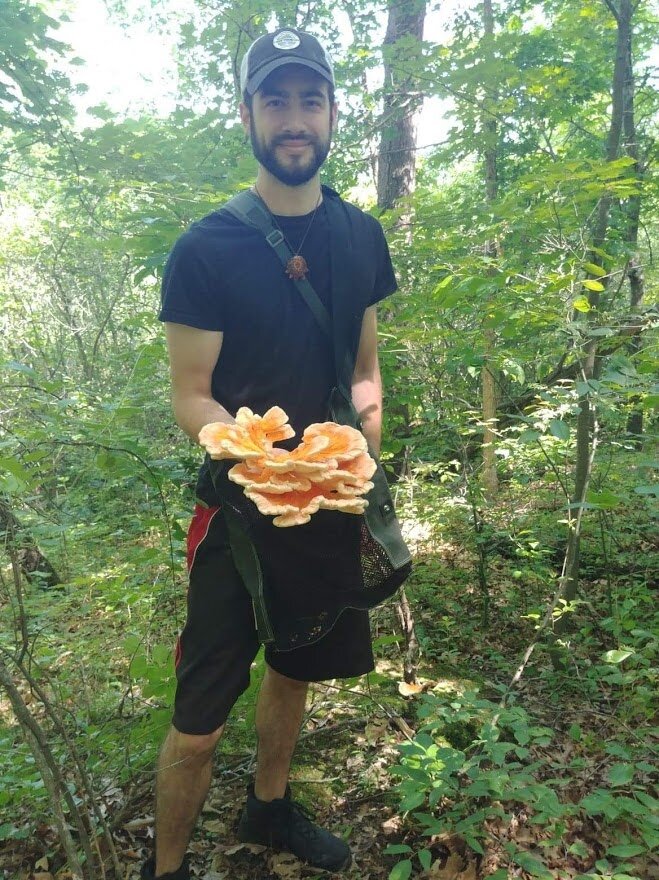Local Knowledge - Derek LaRiviere, Mushroom Guide
If not, well, his name is Derek LaRiviere and he’s a fun guy…to know more, keep reading.
Nature center staffer Allison Posner recently met up with local fungi expert Derek LaRiviere to share in his passion for mushrooms and learn how to forage for, identify, and eat them. If you’re looking for a unique (and tasty!) experience, he’s the guy to connect with.
Derek excitedly agreed to answer some questions regarding life when you’re The Mushroom Guy:
How did you come to be The Mushroom Guy?
Once I started foraging, I was awestruck by the fungal diversity that we walk past every day, and I just wanted to keep learning more. I took a course to get certified to sell wild mushrooms in Michigan, and that made me want to start growing culinary mushrooms too. I used to jokingly apologize for being “that mushroom guy”, and the name kind of stuck.
What can people anticipate when they're out with you on a guided mushroom hunt?
I don’t just teach mushroom identification; I teach its very important partner: tree ID. Many edible mushrooms grow on/from trees, so knowing what trees to look for can really tip the odds in your favor. I also teach the fundamentals to make mushrooms a little less mysterious.
How often do you forage for mushrooms and what's your biggest one-day haul?
Some weeks I go every day, some weeks I go every other day. But my philosophy is if you want to find them you have to put in the time. Sometimes, if you put in the time, you hit the jackpot. One day I found 26 lbs of chicken of the woods on one tree, and another time I found 40 lbs of maitake in two hours (14 lbs of which were around one oak tree).
How is the quality of a mushroom hunt in southeast Michigan? Do you often find variety?
It’s fantastic out here! Spring through fall there are an unbelievable amount of different edible mushrooms in southeast Michigan. I find oysters, lion’s mane, chicken of the woods, maitake, chanterelles, morels, black trumpets, giant puffballs, lobsters, and so much more.
What's the safest way to eat a mushroom?
Only eat what you can verify with a 100% confident ID. Any new edible mushroom you are trying out should only be eaten in small amounts the first time; waiting for an allergic reaction (although uncommon) is a good way to be safe. And, of course, always cook thoroughly.
Do you have a favorite recipe using what you can find around our area?
I love using chicken of the woods mushrooms (since they have a texture very similar to cooked chicken) and battering and frying them to make tenders. Or I use maitake mushrooms and tear them like string cheese, cook them with BBQ sauce, and turn them into “pulled pork” sliders.
Can you share one fun fact about the world of fungi?
What we know as “mushrooms” are just the fruiting body of the organism. Most of the organism is mycelium, and the mushroom is the reproductive stage. Picking a mushroom does not harm the organism, and sometimes can even trigger a second flush of mushrooms.
What resources do you recommend to learn more about our friend, the mushroom?
Adam Haritan has a channel on Youtube called Learn Your Land, which has some really great videos on a variety of different mushrooms. I cannot recommend him enough. Also, mushroomexpert.com is a great place to learn some of the more fine details you may later wonder about.
Any advice for aspiring mushroom hunters?
Join identification groups on Facebook and watch mushrooms get ID'd in real time to build visual intuition, get a good book to get your feet wet (Mushrooms of the Upper Midwest by Kathy Yerich & Teresa Marrone is a good beginners book), and, ultimately, get out there!
Where can we find you on social media?
@mi.mushroom.guy on Instagram!
Based on your personality and experience in the field, if you were a mushroom, what kind would you be?
An oyster mushroom: you can find me in most wooded areas year-round, and I will eat just about anything!


